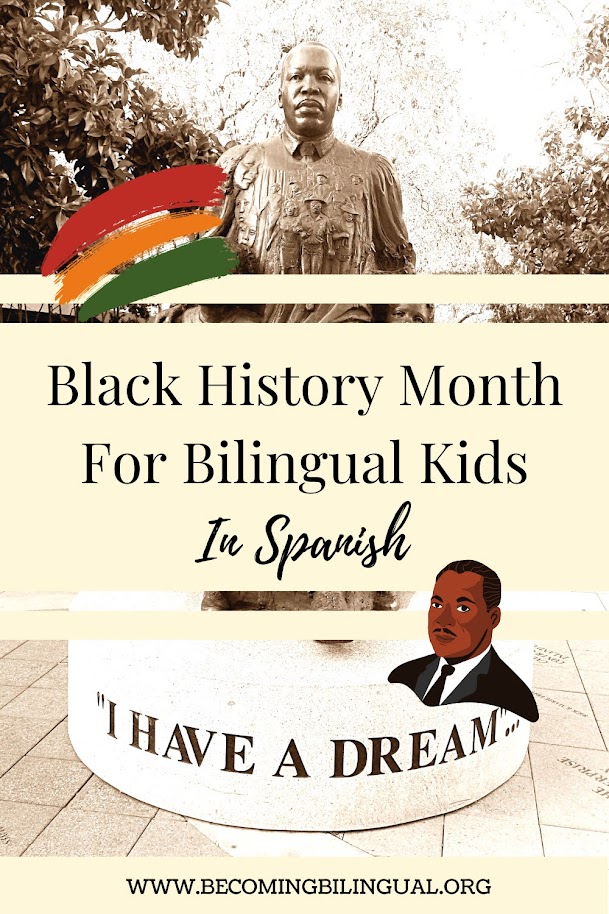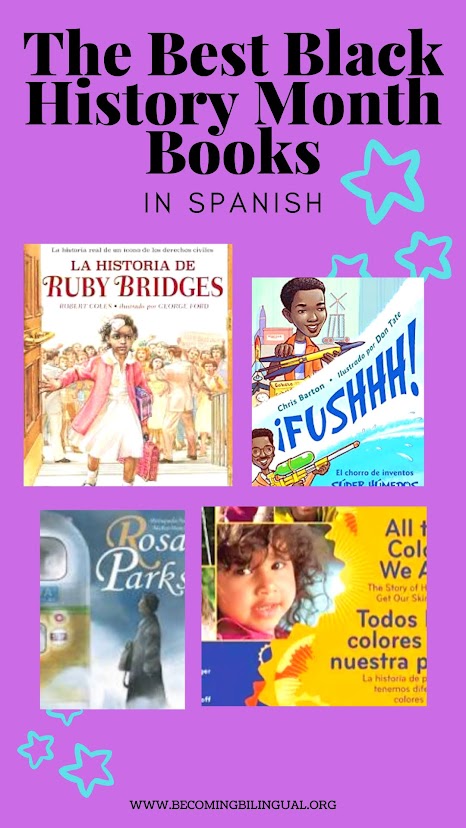Black History Month For Bilingual Kids

February is Black History Month in the United States and it’s a time when many schools highlight the contributions of African Americans to American history.
In order to keep up with my daughter’s Spanish language skills, I started a collection of books that highlight some heroes of the Civil Rights Movement and also African Americans from all periods in American history.
While it’s important to also have fictional books that feature a wide range of protagonists, all of the resources that I’m sharing in this article are real historical figures and these books are mostly biographical in nature.
Since Black History Month is right around the corner, today I wanted to share some of the resources in our collection. I’ll share my favorite Spanish children’s book that talks about what skin color is, some of our favorite books that talk about the Civil Rights Movement and some more Spanish resources to use for Black History Month.
This post contains affiliate links. If you click an affiliate link and make a purchase, I earn a small commission which supports this blog at no additional cost to you. Please see the Privacy Policy for details. Thank you for your support!

Table of Contents
Spanish Resources About Skin Color
When my daughter was 4 years old she started to ask me questions about skin color. She would hold out her arm next to mine and ask why our skin was a little different. She’d point out that the skin on her arm was darker than the skin on her stomach. She’d talk about how her good friend had a different color skin than hers.
Talking about skin color with children is an important topic.
You can start laying the foundation for a scientific basis for why humans have different shades of skin tone and help curtail any myths or bias they might have about that.
One of the absolute best resources that I found for this is the book, “Todos los Colores de Nuestra Piel” which is a bilingual hardcover book.
There is just no other children’s book that so accurately and concretely explains why humans have different shades of brown skin. It explains that there isn’t actually such a thing as “white skin”, “black skin” or “yellow skin”, that skin is all variations of brown.
My daughter’s favorite page shows various shades of skin color around a single hand print. She puts her hand in the hand print and tries to match it with the color that most resembles her own skin tone.
I also love that the book includes all real life photographs and that it has ideas for activities to do with your child. We have done several of the activities suggested in the back of the book and it just creates more conversation and allows space for my daughter to explore skin tone.
Regardless of your child’s age, talking openly and factually about skin color is a great way to curb misinformation that they might have.
Civil Rights Books In Spanish
Once my daughter started school and started to learn about Black History Month she was a little confused about racism. Why would people be treated differently based on their skin color, which was just like hair color or eye color? Why would it matter where they were from?
To support her learning at school, I tried to start a collection of Spanish resources at home that explained some of the key figures of the Civil Rights movement in the United States and the history behind segregation in the United States.
While this isn’t a complete list of all of the Spanish books out there, here are some of the books that I have found that have strong factual information and explain some of the history of Rosa Parks and Martin Luther King Jr in a way that a child could understand.
For an amazing Spanish graphic novel about the work of Rosa Parks during the Civil Rights Movement, check out my review of the Spanish graphic novel, “Rosa Parks” here.

Black History Month Books for Kids in Spanish
Black History Month was started as a way for Americans to recognize all of the important achievements and contributions made by Black Americans from all periods of American history.
Instead of just lingering on the history of slavery and the Civil Rights movement, it is important to recognize all of the contributions that Black Americans continue to make to American life.
Here are some of the books that I have found and read with my daughter that highlight the work of African Americans outside of the Civil Rights movement.
While this is also not a complete list, it has some really well written books and can easily help your child start to value some more important Black figures.
If you’re looking for more books on Hispanics or Afro-Latinos, check out this article – Hispanic Heritage Month Biographies For Kids
Spanish Video Resources for Black History Month
Another great resource for learning about Black History Month is Spanish is to watch some quick videos on it.
It’s great for developing Spanish listening comprehension and it also gives more vocabulary and kid friendly explanations of what’s happening. Here are a few that we’ve watched in Spanish.
SmartKids: Mes de la historia afroamericana
This is a quick episode that’s geared toward younger students, ages 4-7. It does a quick overview of what it means to celebrate “el mes de la historia afroamericana” and then it shows a few key figures from United States history.
AfroUp: La Herencia Africana en América
This is also a quick clip but it’s intended for slightly older audiences, 10+. The level of Spanish vocabulary is higher and it’s done at a faster speed. The video explains how Africans arrived in the Americas, what traditions they brought with them and why we celebrate Black History Month in the Americas now.
I hope that this is a helpful resource for you as you celebrate the contributions of African Americans this month and every month!
Happy Learning!
Don’t forget to subscribe here so you can get my latest posts and resources delivered directly to your inbox!








